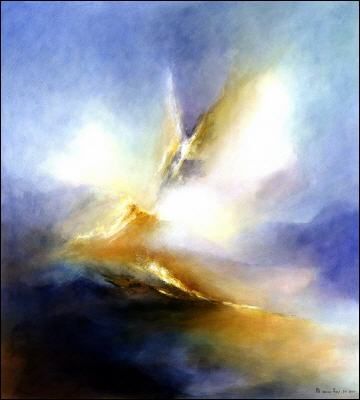Organic painting

Colour perception
It is possible to establish a personal connection with colours. Indeed, each colour has its own character, intensity and quality. Approaching colours as living beings, each with its own characteristic, was first put forward by Goethe and later further developed by Rudolf Steiner. From this new approach to colour theory, a new painting technique also emerged, which I myself have come to call "organic painting" (also called glazing technique or wet-on-wet painting).
A painter has to deal with the polarities of light and darkness between which the wonderful world of colours that we can perceive with our eyes becomes visible. Not only colours can be experienced as living beings; the transparent water used to paint is also a living element to which nature beings and life forces are connected (see: Emoto)
Self-taught
I have mastered the painting technique I use over the past 30 years. I make my own paint mixtures from vertebrate water into which I dissolve pigments and essential oil. This coloured, essential oil water contains a lot of life force, a lot of shaping power and natural dexterity and can be compared to painting with vegetable paint.
For me, however, it is important to work with colourfast, mineral pigments because plant paint is mainly used therapeutically and fades (too) quickly. To replace the vegetable element, I therefore add essential oil to my colour mixtures. I distil this oil myself in a copper distillation kettle.
Composition / representation
As described above, organic painting is mainly about the colours expressing themselves naturally on the canvas, rather than striving for a recognisable form. By applying hundreds of thin, transparent layers of diluted paint to the canvas, deep, intense colours can be created. A form of abstract art, then, you might say. However, do not compare it to expressionism where an artist mainly gives free rein to his own emotional life. Organic painting is instead about restraining one's own emotion. This requires practice, inner training, self-power. So organic painting is closely linked to inner self-control. So as a painter, I keep myself in the background as much as possible and look with curious eyes at what wants to emerge. I let the colours have a dialogue with each other without trying to direct them myself. This results in lively, cloud-like paintings with a colourful interplay between light and darkness. A painting is "finished" when a balanced balance has been found and what wanted to be said has been said in colour and contrast and every colour has come into its own.
Alchemy
I learnt this technique, the technique of endless restraint and wonder and dissolving any tendency towards form, from Ad van der Lugt (pictured above) from whom I took private lessons during my student days. I learned from him to put down the brushstroke in the rhythm of my heart and breathing. With endless patience and without hurry or pressure, staying connected to the present moment, until light starts shining out of the painting, through the colours. I learned that organic painting means living painting. How to learn to transform minerals and pigments into shining gold. In this respect, organic painting could also rightly be called a form of Alchemy and the artist a kind of magician. Not surprisingly, Goethe, in addition to being a natural scientist and writer, was also intensely involved in the art of magic. In fact, he was also a magician. Not everyone knows that....
© Waldar 2025




